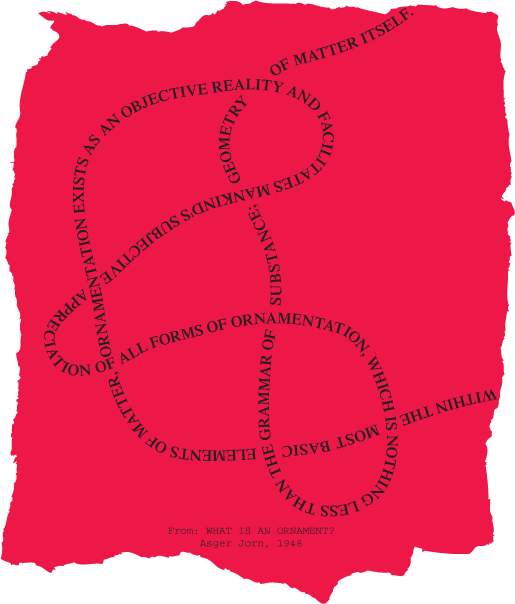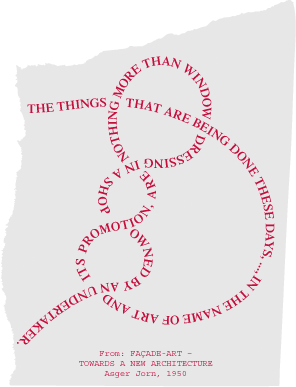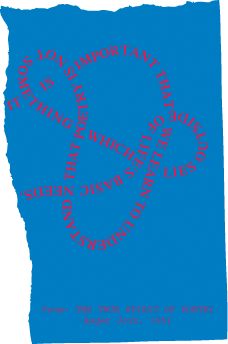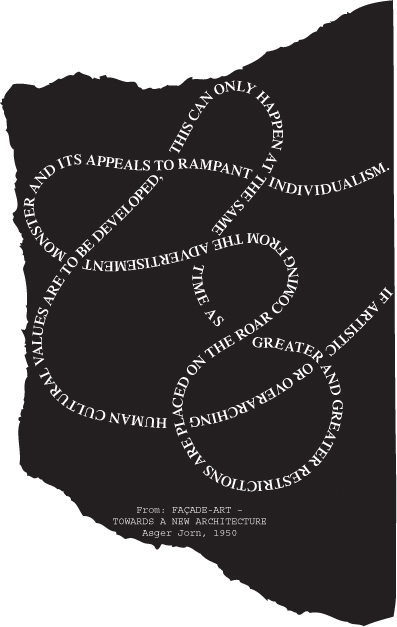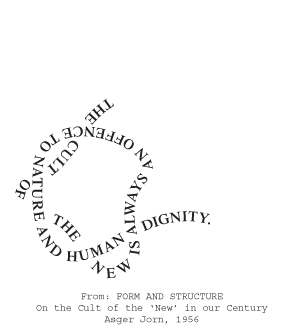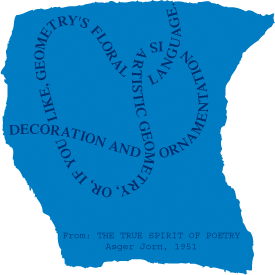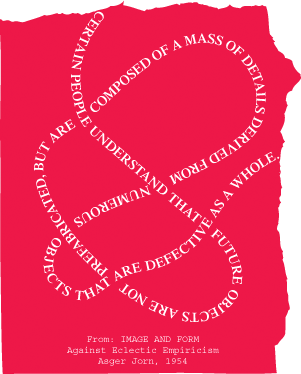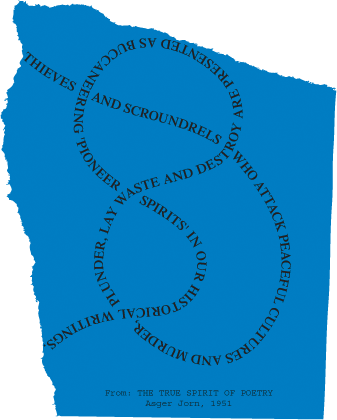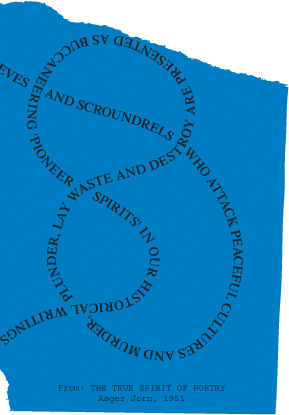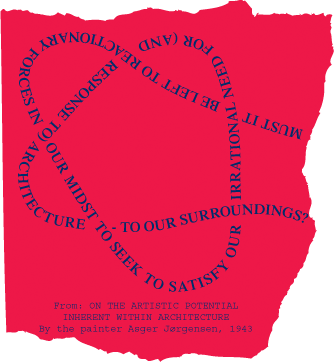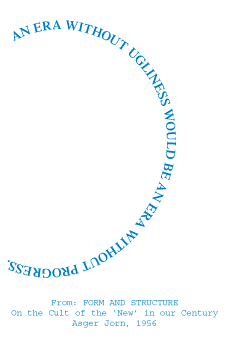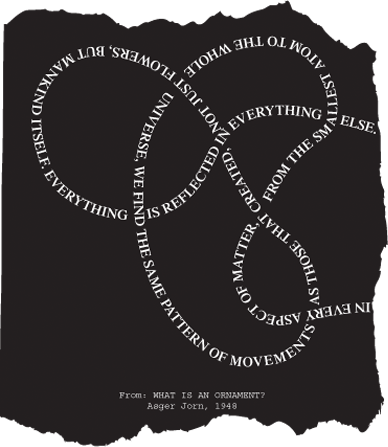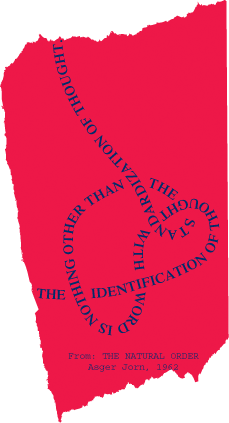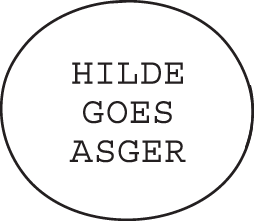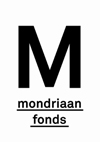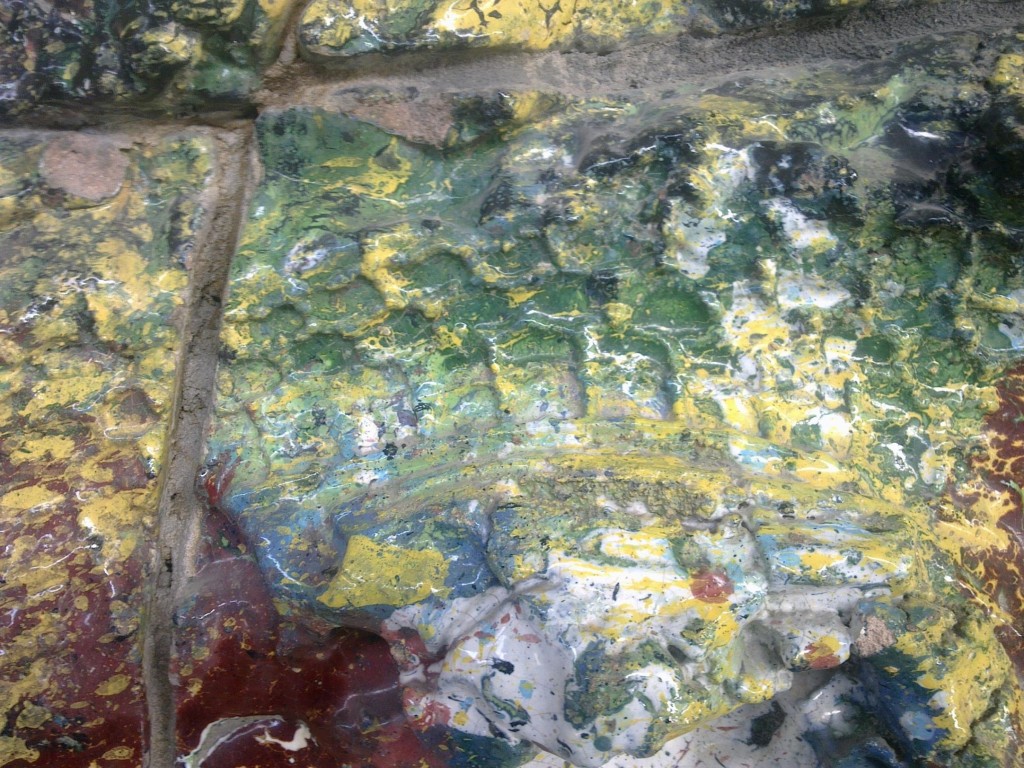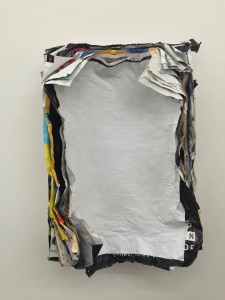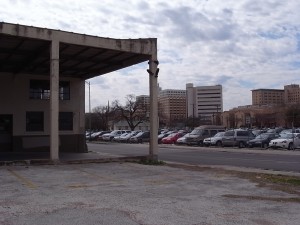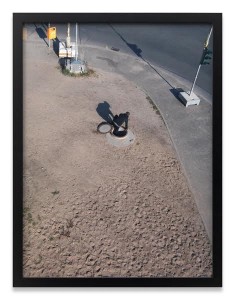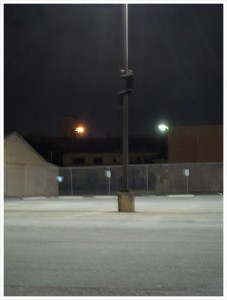KLARA LIDÉN, PILLAR HUGGER
In 2012, when I applied for a so-called mediators grant to support a curatorial research into Jorn’s writing and thinking I played around with the idea to look at the work of the Swedish-born contemporary artist Klara Lidén (1979) through the lens of Asger Jorn’s ideas on vandalism. Now, 4 years later, Zoë Gray, Senior Curator at the centre for contemporary arts Wiels, in Brussels, gave me the incentive to finally do so for a lecture in the framework of the exhibition Klara Lidén: Battement battu (29.10.2015 – 10.01.2016). The text is a slight adaption of the lecture that I held on January 6th, 2016 at Wiels. I would like to thank Zoë Gray, and I would also like to thank a range of art historians and other Asger Jorn specialists whose perspectives have been highly informative to this lecture including Ruth Baumeister, Helle Brøns, Niels Hendriksen, Karen Kurczynski, and Peter Shield.
Asger Jorn
Let me introduce the first one of the protagonists of this lecture in more detail: the Danish experimental artist and thinker Asger Jorn (1914-1973) was one of the founding members of the Danish Høst group (1934-1950) and the associated magazine Helhesten which he founded (1941–44); the international experimental Cobra group (1948-1951); the Movement International for an Imaginist Bauhaus (1953); and the Situationist International with among others Guy Debord (or SI, 1957–1972), and the Scandinavian Institute of Comparative Vandalism (1961-1965).
To Jorn’s own way to go about we could certainly attribute ‘vandalistic’ tendencies: he would cut out images, scribble or underline passages in his own books (as well as in the books of others), he would buy bourgeois, academic style Sunday school paintings at the flea market and alter them, he would for several years in a row go back to the house of the collector of his largest painting to continue altering the painting because the buyer had made a comment about the work perhaps ‘still missing something’, he would run a scooter over a large clay relief leaving the tire track visible in the end result, and he would tear down tick layers of posters in the streets of Paris to ‘décollage’ them.
Even the way that Jorn used photography in for instance his book Signes gravés sur les églises de l’Eure et du Calvados (1964, on mediaeval graffiti on churches in France) has been labelled ‘vandalistic’ for the continuous disconnection of the photographs from historical chronology in favour of a purely visual order (Niels Hendriksen).
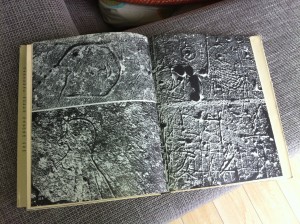
Asger Jorn, Signes gravés sur les églises de l’Eure et du Calvados, 1964
Klara Lidén
Protagonist number two is the Swedish artist Klara Lidén (1979) who lives and works between Berlin and New York. Lidén works with performance, interventions, video, installation and sculpture. Her main interest is an exploration of the physical, psychological and social limits and conventions of both public and private space; the street as an endless source of inspiration and action; an obsession with recycling and transforming urban materials; physical gesture and use of the body. She has recycled waste packaging into makeshift hideaways, turned old posters into paintings, along with many other kinds of creative vandalism.
Like Asger Jorn’s décollages, Lidén’s Poster Paintings series consists of layers of glued-together advertisement posters taken from the streets, but in contrast to Jorn who reveals so to speak hidden compositions, Lidén’s sole addition is a white top sheet. A series of spray-paint works on paper by Lidén show traces, prints of everyday life items that the artist finds in her studio or among her personal belongings, including her bike. Again an image that reminded me of Jorn, of his clay relief.
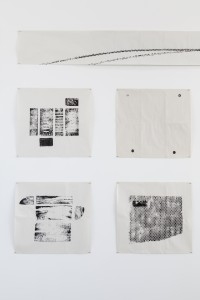
Overview of various works on paper with spray paint by Klara Lidén, exhibition detail, Wiels, Brussels, 2015.
Lidén’s photograph Bowery (2012), showing a figure that has climbed on to a street sign at an intersection; and Column Monkey (2013), in which we see how she ascended on the pillar of a deserted building in an urban zone reminded me of images in one of the publications of Jorn’s SISV.
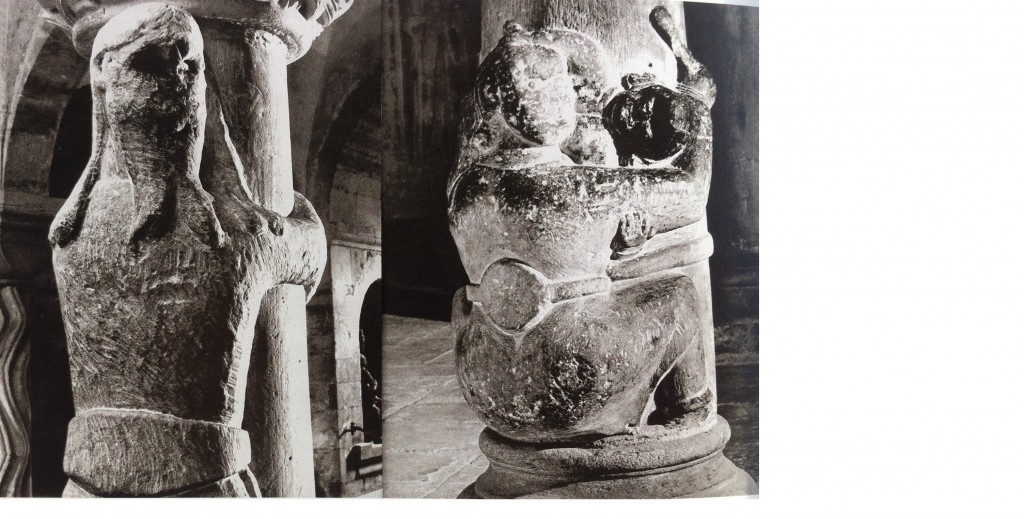
Pillar-breakers or pillar-huggers at Lund Cathedral, photograph by Gerard Franceschi in Jorn’s publication “Skånes stenskulptur under 1100-talet” (12th-Century Stone Sculpture of Scania), 1965.
JORN ON VANDALISM
Not only did Jorn display a ‘vandalistic attitude’ within his own art practice, throughout his writings he also theorized on the concept of vandalism but of course, the concept is part of a web of other notions, and I decided to simply take a few of these as a starting point for further analysis and speculation.
Value
In relation to the notion of value I would first like to bring up the vocabulary of the Situationist International, which happens to be frequently mentioned in relation to Klara Lidén’s work – especially the notion of détournement. Détournement is usually translated into English as ‘diversion’. An English translation of the Situationist publication Détournement as negation and prelude[1] (originally published in French in 1959) says: “Détournement, the reuse of preexisting (artistic) elements in a new ensemble, has been a constantly present tendency of the contemporary avant-garde, both before and since the formation of the SI. The two fundamental laws of détournement are the loss of importance of each detourned autonomous element — which may go so far as to completely lose its original sense — and at the same time the organization of another meaningful ensemble that confers on each element its new scope and effect.”
Artistic examples of detourned expression include Jorn’s previously mentioned modifications, his altered Sunday school paintings. As Karen Kurczynski writes in The Art and Politics of Asger Jorn, with these kind of works “Jorn expressed an overt critique of the social exclusivity of high art from classicism to modernism and beyond.”
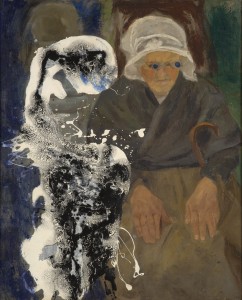
Asger Jorn, Modification with Brittany Woman, 1962. Collection Cobra Museum of Modern Art, long-term loan by Karel van Stuijvenberg,
On the occasion of an exhibition of these type of paintings, Jorn wrote: “In this exhibition I erect a monument in honor of bad painting. Personally, I like it better than good painting. But above all, this monument is indispensable, both for me and for everyone else. It is painting sacrificed. This sort of offering can be done gently the way doctors do it when they kill their patients with new medicines that they want to try out. It can also be done in barbaric fashion, in public and with splendour. This is what I like. I solemnly tip my hat and let the blood of my victims flow while intoning Baudelair’s hymn to beauty.”[2]
But despite this colourful remark, Jorn’s ‘vandalistic’ approach was never aimed at one-dimensional disrespectful destruction. This is also illustrated well by something else Asger Jorn said about his modifications in the same text:
Be modern / collectors, museums / if you have old paintings / do not despair / Retain your memories / but detourn them / so that they correspond with your era. / Why reject the old / if one can modernize it / with a few strokes of the brush. / This casts a bit of contemporaneity / on your old culture. / Be up to date / and distinguished / at the same time. / Painting is over/ You might as well finish it off / Detourn (détournez) / Long live painting.
Contemporary art historians tend to think of the modifications as re-valuations, or as “progressive use of tradition”. As Helle Brøns points out Jorn fully recognized that the creation of new values by devalorization is only possible where there is something to de-valorise, i.e. where a recognized value already exists. Brøns: “There is a fundamental difference between Debord’s attitude to the détourned material as something losing its significance, and Jorn’s maintaining – in part – its original value.”[3]
An artistic example of the use of detourned expression in Klara Lidén’s work could be the previously mentioned Poster Painting series. The posters lose their autonomy, and the reorganization by the simple gesture of adding a blank top sheet undermines their presumed message. The title of these works make a general reference to painting, the blank top sheet suggest a particular reference to the tradition of the abstract monochrome in modernism, the ‘upgrading’ of street posters to ‘high art’ could (as was the case with Jorn) be read as an overt critique on the social exclusivity of high art.
Below, I will discuss the next point that is also intertwined with Jorn’s thinking about vandalism but that leads to a pointing at some fundamental differences in Jorn’s and Lidén’s respective practices.
Progress
In Jorn’s texts the complete freedom required to create pure experiment, and the transgression of existing modes of thinking and pre-established norms and ideas, are inextricably linked to the notions of progress (and risk). In his text ‘Charms and Mechanisms – upon the role of vandalism in the history of arts’ (published in French in 1958 in his collection of essays Pour la Forme (the first substantial publication within the Situationist International) Jorn also brings up the example of the testing of new medicine (like with the detourned paintings when he speaks about “the blood of my victims”). He uses this example to illustrate the fundamental idea that risk, the notion of loss (or potential loss) are in fact an intrinsic part of progress. “I wager this clear idea”, Jorn says: “that there will never be any progress without tragic consequences. The gamble with life is the origin and the price of all progress.”[4] In other words: all progress is vandalistic and barbaric.
So what else does Jorn’s perspective on progress entail? In Charms and Mechanisms he states that he believes in progress, but that as an artist he rejects “any ethical interpretation of progress understood as moving towards happiness, justice or whatever.”[5] Jorn’s rejection of this interpretation might have been influenced by the Danish philosopher Kierkegaard, whose writings Jorn was very familiar with, and who belongs to a generation of thinkers who, I quote the Finnish philosopher Georg Henrik von Wright: “in the course of the nineteenth century had clearly distanced themselves from the idea of the myth of progress” and who according to Von Wright were “not necessarily pessimistic but in a sombre mood of self-reflexion and questioning of dominant currents of their time.”
Based on this more critical attitude, Jorn’s take on progress is instead, I quote: “(…) simply the feeling one has when one moves forward, on a train, for example, and sees the countryside disappear in the opposite direction. The feeling of progress implies losing something while gaining something else.”[6] “It is only by change, that is to say by movement, that the notion of time is available to us … If there are no events there is obviously no sequence, and consequently no time.”[7] According to Jorn, it is the direct goal of the arts to create these events – it is the speciality of the arts to do so. In his own practice this meant that he always aimed to create what he called “the greatest sensorial significance” by varying and diversifying processes.
Despite his rejection of the idea that progress necessarily implies improvement, one of Jorn’s motivations to write Charms and Mechanisms stems from a concern over the declining power of the human race to evolve. In our struggle for reason, we are abandoning this power, Jorn says, by “giving up all irrational or artistic activity in the sphere of the imagination” – whereas it is exactly this activity that generates new knowledge, artistic knowledge[8] (which Jorn also refers to as “comprehension without recognition”).
The Myth of Progress
Klara Lidén has been preoccupied with the notion of progress as well, as is illustrated in the titles of some of her works and the title for her solo exhibition, at the Irish Museum of Modern Art in Dublin in 2014: The Myth of Progress. She took the title from an essay by the aforementioned Finnish philosopher Georg Henrik von Wright (1916 – 2003).
As Jacques Bouveresse points out in his article ‘Wittgenstein, von Wright and the Myth of Progress’[9] Von Wright wasn’t critiquing progress itself, but critiquing the idea that progress is unbounded and everlasting, natural and necessary, and that this type of progress is inscribed in the nature of human beings as a species. Bouveresse quotes Von Wright: “(…) we may seriously wonder whether the idea of unlimited progress, understood in such a way, is not liable to enter into contradiction at some point with the natural species itself, which necessarily implies an environment and living conditions which must also remain, at least to a certain extent, natural, and cannot be transformed in any way we could like and without any limits.”
In contrast, Asger Jorn is aware of the risks that come with progress (its ‘vandalistic’ aspect), but accepts the risk, while maintaining a desire for, or a belief in progress. In his artistic practice this translates into an experimental working method based on bringing about variation and diversification. Large parts of his artistic output, consist of taking existing elements and altering them, resulting in a new objects that now say something else. Think of his modifications, or of his décollages.
In comparison Klara Lidén, who we could argue lives in a world that starts showing the actual consequences of unlimited progress, seems to add just the minimum to a world already overloaded. There is a stronger focus on conceptual, minimal gestures such as with the stacked pieces of asphalt, or with the Poster Paintings: when Klara Liden takes a thick layer of posters from the street and alters it, strictly speaking, she doesn’t add another/her own voice, she rather mutes the original message.
Or, where Lidén leaves a modest bike tire trace on a piece of paper, Jorn leaves behind the noisy tire track of a scooter on the largest clay relief in Europe (27 meter); where Jorn has written hundreds of texts and engaged in public discussions, I can only find a modest amount of interviews by Klara Lidén, and where Jorn co-established various artist groups all trying to raise their voice, always discussing and debating, also amongst themselves, we see Klara Liden on her own, or as a solitary individual even if amongst a group of other people (such as in her well-known video Paralyzed, 2003, in which she does a wild, uninhibited dance on a commuters train in Sweden). In conclusion, I would like to speculate that it is perhaps Jorn’s and Liden’s respective perspectives on the notion of progress are accountable for these kind of differences in their artistic output.
I will now jump to the last notion that is closely related to Jorn’s ideas on vandalism, which is the notion of resistance.
Resistance
From an intellectual point of view Jorn was interested in vandalist expressions as acts of resistance against the reigning order: the graffiti that he found on the churches in France was supposedly made by Viking “vandals”, and the book 12th Century Stone Sculptures of Scania is emblematic for the SISV approach by demonstrating a subtle subversion of the iconography of power. This aforementioned book which includes the image of the pillarhuggers/breakers traces the infiltration of a non-Christian iconography of beard-pullers, double-heads and pillarhuggers in the decorative programs of churches built in the aftermath of the annexation of Scania by the recently converted kingdom of Denmark around the year 1000.
The subversion of existing hierarchies and power relations runs through Jorn’s thinking and practice as a red thread. In Charms and Mechanisms, when Jorn speaks of what distinguishes the artist from “his adversary” he characterizes the artist as the one with conscious opposition to the reigning order in life and places what the calls the “grotesque folly of a too probable existence played out in advance” in direct opposition to the “pure desire for the unexpected, the thirst for surprise, the longing for the absurd, and the attraction of the abnormal, in short, towards diversion, amusement, the ‘dérive’.[10] And a bit further on he writes: “all artistic structurations are just different forms of networks of resistance against movements. (…) all we need to point out here is that artistic currents cannot, as imagined by politicians, serve directly to unify and accelerate general social movement. On the contrary, as counter-currents they are engaged in enriching, diversifying and enlarging the importance of an existing movement by diverting it.”[11]
What speaks from these citations is Jorn’s love for dialogue between a plurality of voices, which is not only part of his thinking, it is also expressed in the collaborations that he was always looking for. To Jorn the dialogue with others, whether harmonious or conflicting, was never supplementary or subsequent, but foundational to his practice and the way he dealt with art as a public phenomenon. Within these collaborations Jorn was fiercely opposed to watered-down consensual results. He believed that consensual strategies needed to be avoided in order for everyone involved to give their very best. The dialogues that Jorn was looking for, were of a more polemic, combative nature. In contemporary terms we could perhaps even speak of Jorn’s attitude as agonistic. “Within agonistic theory disagreement and disputation as deemed necessary, rather than negative components of political and social life”, they are considered “constituents that are at the foundation of an active, vigorous instantiation of citizenship. Within this conception of the public sphere no boundaries or borders can remain unchallenged.”[12]
In conclusion we could say that Jorn, who despite his statement about the rejection of an ethical interpretation of progress, is still driven by the idea that artists and architects could potentially make a difference, testifies of a resistance that is so to speak ‘loud’. In contrast Lidén’s seems a mute resistance, perhaps even totally devoid of risky dreams of a better world. As Helen Molesworth writes in an excellent article in Art Forum when discussing Lidén’s practice: “the artist at work is imaged as silent, sullen, solitary, and quite possibly self-defeating.”[13] Molesworth speaks of a “muted, nearly autistic sensibility” in relation to Lidén. But what does that imply in regards to the notion of resistance, of critique in her practice? Obviously she is not looking to argue, to engage in an active, vigorous instantiation of citizenship ….
Perhaps we should take the term postcritique, a notion that was brought up by Helen Molesworth in the same text, into consideration. The way I understand the term postcritique (though admittedly based on very limited knowledge), suggests that Lidén belongs to a generation that is critical of universal normative principles. A generation that as such is not primarily concerned with these, whereas nevertheless looking for the possibility of critical resistance to moral and social ills. However, as David Couzen Huoy points out in his book Critical Resistance – from Poststructuralism to Postcritique the type of resistance, the in-your-face refusal, exemplified by the famous students uprisings in Paris in May 1968, in which the Situationists International played such a preponderant role (to some extent their political perspective and ideas fueled such crisis), has been replaced by another. The ’68 motto “we are realists, we demand the impossible” nowadays simply means “to resist globalization of capitalism even when one does not have a better alternative to offer” (here Huoy sketches the perspective of Slavoj Zizek).
This perspective might offer an explanation of why Florence Waters in a 2010 review in the Telegraph on Klara Lidén’s solo show at the Serpentine Gallery felt compelled to write that it: “(…) is the knowing futility of Liden’s gestures that separates her from the previous generation of art vandals.” And that, “Unlike her forefathers, Liden’s message is too suffused with irony to be political. She seems, almost, to be poking fun at her predecessors (…) for the naivety of the idea that art would be grand enough to really change anything.”[14] Also Helen Molesworth discusses some of Liden’s works as “the staging of what may be the central dilemma of today’s emerging artist: the futility of being one in the first place.” She writes: “And spending time with her work, one realizes that the twentieth-century paradigm of art’s utopian aspirations is not what’s at stake. Lidén offers blankness—and its aural handmaiden, muteness—less as a critique or a way out than as a condition, less as a program than as a given (reduce, reuse, recycle). In her work, I sense a tacit acknowledgment that the jig is up, that being an artist is just another way of getting by, a coping strategy for living under late capitalism.”[15]
Perhaps this ‘just another way of getting by attitude’ (I’m sure that I’m making it sound more negative then Molesworth intended) is a justified observation. I can see why it would be. I can then also see how this attitude is ground for critique that was expressed in a review in Frieze of a group show in which Lidén was participating. In the article some of her work, as well as that of some other artists, was criticized the following way, I quote, “the pointing towards resistance and subtle undercurrents of violence became the objects of aesthetic contemplation.
This was palpable in Klara Lidén’s series of framed black and white photographic prints, including Untitled (Down) (2011) and Untitled (Monkey) (2010). In these images, a distant person traces alternative routes through the city, up concrete pillars and down manholes. These works did not merely speak of an aesthetic of revolt, but also of the fetishization of resistance.”[16]
But I am having a hard time to buy the ‘just another way of getting by attitude’. Perhaps I simply find it too depressing, but I also guess that there are much much easier ways of getting by then being an artist. And funnily enough, the works criticized in Frieze magazine, are pretty much the same works that led Darran Anderson in a passionate and positive review of Lidén’s solo exhibition at IMMA to conclude that she “demonstrates that we can resist through small imaginative acts of revolt, or at least express our alienation.”[17] Anderson brings up the humorous aspect of the work, as well the notion of danger and risk (public ridicule, attention of authorities, physical harm). And he speaks of how in these works, Lidén’s presence in public space communicates that “any attempt at individuality or real interaction with the surroundings will have stern and immediate consequences”. Crucially, Anderson also adds that “Critically, these are unspoken warnings, existing already in our own heads.”
So what perhaps primarily becomes obvious from Anderson’s observations, is that we are not looking at an artist who is ironic up to the point where the work stops being political, or whose artisthood is just another way of getting by. Lidén belongs to a generation that knows too well (to quote from David Huoy’s book) “that domination and resistance are intimately related to each other, that perception of social constraints is itself produced by social constraints, and thus is just as likely to perpetuate these constraints as to escape them.” What seems to be ‘just another way of getting by’ might in fact be a constant struggle, a way to resist the pitfall of not recognizing that “power and domination may (…) be more complex than it appears on the surface, that the social features that are being resisted may produce the shape that resistance takes.” (Huoy uses the example of a teenager who imagines a world without parents is in fact still presupposing the subject identity teenager and therefore the same social organization that is resented).
In that sense we could think of Lidén’s strategies (the muteness, the solitary acts, the ironic humor, the use of her own body) as highly politically informed strategies all aimed to create “latent and subversive relationships to representation” (as Carl Kostyal expressed it in the same Frieze review on a more positive note on Lidén’s work). I would like to think of Lidén’s repeated performance or embodiment of the pillarhugger/breaker (coming from Sweden she might very well know the mediaeval predecessors in the Lund cathedral) as emblematic for her interest in subversive relationships to representation.
With Column Monkey and similar works, Lidén expresses an interest, like Jorn had, in a transformation of the inorganic to the organic function, challenging the fundamental, static character of architecture. And as Niels Hendriksen points out in his article on Jorn’s Scandinavian Institute of Comparative Vandalism, things and beings that are in a state of transformation inherently hint at subversive relationships to representation, as they hint at cultic metamorphosis, in which value is mutable, where dragons, fish, and other creatures are turned into princes and princesses who in turn become deer, birds, and ghosts. This conflicts with the Judeo-Christian metaphysical world order that stands above nature and matter, and in which (in Christian iconography) the stability of animal symbols serves to perpetuate societal hierarchies.[18] Unlike Asger Jorn though, Klara Lidén is not only interested in investigating the subversive nature of the representation of metamorphosis: by making use of her own body, she becomes the pillarbreaker.
[1] The full text can be found here http://www.bopsecrets.org/SI/3.detourn.htm
[2] Asger Jorn, ‘Detourned Painting’, in: Hvad skovsøen gemte / Jorns Modifikationer & Kirkebys Overmalinger, Museum Jorn, Silkeborg, 2011, p. 132-133.
[3] Helle Brøns, ‘The Shock of the Old’, in: Hvad skovsøen gemte / Jorns Modifikationer & Kirkebys Overmalinger, Museum Jorn, Silkeborg, 2011, p. 136.
[4] Asger Jorn, ‘Charms and Mechanisms – upon the role of vandalism in the history of arts’, in: Concerning Form – an outline for a methodology of the arts, Museum Jorn, Silkeborg, 2012.
[5] ‘Charms and Mechanisms’, p. 107.
[6] ‘Charms and Mechanisms’, p. 107.
[7] ‘Charms and Mechanisms’, p. 108.
[8] ‘Charms and Mechanisms’, p. 109.
[9] Paragraph, volume 34, issue 3, page 301-321, ISSN 0264-8334, Available Online November 2011. The full article can be found here: http://dx.doi.org/10.3366/para.2011.0027
[10] ‘Charms and Mechanisms’, p. 112/113. Dérive is a mode of experimental behaviour connected to the conditions of urban society: a technique (used by the Situationists) of transient passage through various ambiences.
[11] ‘Charms and Mechanisms’, p. 117.
[12] Rafael Schacter, Ornament and Order – Graffiti, Street Art and the Parergon, Ashgate, 2014, p. 95.
[13] Helen Molesworth, ‘In Memory of Static’, in: Artforum, March 2011, p. 217.
[14] The review can be found here: http://www.telegraph.co.uk/culture/art/art-reviews/8056879/Klara-Liden-Serpentine-Gallery-review.html
[15] ‘In Memory of Static’, p. 222.
[16] Carl Kostyál, Awaiting Immanence, in: Frieze, Issue 157, September 2013. The review can be found here: http://www.frieze.com/issue/review/awaiting-immanence/
[17] Darran Anderson, ‘Klara Lidén: The Myth of Progress’, in: Studio International, 18/11/2013. The review can be found here: http://www.studiointernational.com/index.php/klara-liden
[18] Niels Hendriksen, ‘Vandalist Revival: Asger Jorn’s Archeology’, in: Asger Jorn, Restless Rebel, Statens Museum for Kunst, Copenhagen, 2014.
A MONTAGE OF ATTRACTIONS (JORN – CABRAL)
The two photographs come from different worlds and different periods in time. Both revolve around two men that did not know each other.
I came across the first photograph at the Museum Jorn in Silkeborg, Denmark. The other is from the private archive of Manecas dos Santos, who was in command of the northern front during the liberation fight in Guinea-Bissau. It was shown to me by a friend, Catarina Laranjeiro, who has been engaged in recovering private photographic archives from previous freedom fighters in Guinea-Bissau.
The first image is taken by an unknown photographer probably some time in the 1930’s. It shows the Danish avant-garde artist, writer and thinker Asger Jorn (1914-1973) mounting a painted canvas on the outside wall of a country house, probably in the Danish region of Jutland, while being watched by a man and a little girl. In the second photograph (photographer also unknown and taken in the early 1970’s) we see a group of freedom fighters from PAIGC, The African Party for the Independence of Guinea and Cape Verde, somewhere in Guinea-Bissau. While two of those men set a mortar probably to bomb the Portuguese colonial troops, Amilcar Cabral (1924-1973), wearing the sumbia (a knitted cap worn by many men mostly in Guinea-Bissau, Gâmbia and Senegal), inspects the landscape as two others also do. Cabral was a Guinea-Bissauan and Cape Verdean agricultural engineer, writer, and a nationalist thinker and one of Africa’s foremost anti-colonial leaders.
It seemed to me before, in an ineffable way, that the figures of Jorn and Cabral somehow attracted each other, hence the reference in the title to “Montage of Attractions”, a montage method practiced by filmmaker Sergei Eisenstein. The energy in Cabral’s texts “The weapon of theory” from 1966 http://www.marxists.org/subject/africa/cabral/1966/weapon-theory.htm and “National Liberation and Culture” from 1970 http://www.historyisaweapon.com/defcon1/cabralnlac.html seemed to dialogue with the energy in Jorn’s words, especially those in the publications released with Jorn’s Scandinavian Institute of Comparative Vandalism founded in 1961. The linkage of the images of these two men formalize and formulate that attraction.
The concept that emerges from this attraction is the one of Emancipation. In both images we see people preparing their instruments of emancipation. This emancipation depends on reactivating the links to the layers of ancestry knowledge that modern society disabled, in order to satisfy the need of its productive system. The construction of the future lies on understanding the relation of the present with its ancestry through concrete actions pursued on the field.
Cabral and his men seek to emancipate from the domination of a colonial imperialist system by relinking with the historical process of Guinea (Africa) before the Portuguese (European) domination. Jorn seeks to emancipate from the domination of a dialectical system of thinking that leads to dualistic notions by introducing a triolectic system of thinking that leads to complementarities instead of dualities.
The drawings attached to these images were made under the influence of this attraction with the concept of Emancipation on the horizon with the literal intention of drawing links between apparently diverging energies on a piece of paper.
Daniel Barroca, 2013
BLOG DESIGN
Interview with Richard Niessen, from Niessen&DeVries
HdB: Around two months ago I invited you to make a design for this blog. How would you like to introduce your practice to the readers of this blog?
RN: We are Richard Niessen and Esther de Vries, and we officially collaborate as graphic designers from 2008. We both studied graphic design and live and work in Amsterdam. Even though our individual work is visually quite different, we share a strong interest in close collaborations with commissioners – as a way to challenge ourselves to explore new paths. Our work varies from printed matter, exhibitions, textile, and ceramics to other objects, such as coins. Apart from creating commissioned work for (mainly) cultural entrepreneurs we also initiate our own projects, and Esther also runs a small publishing house.
In my own work I go against the grain of the dogma of unambiguity in concept which is prevalent in ‘Dutch Design’. Instead, I am trying to search for multiple layers, I would call it ‘lyrical design’: expressive and fantastic, making use of a rich visual language to address the senses and the intellect. My work is engaged, subjective and personal. It is also spontaneous, I would even say interactive and the meaning is usually ‘sedimented’ in layers. Just like in the assignment fort his blog, where also many layers add up, not in an immediate transparent way, but still clear. In my work it is always possible to find some hidden secrets.
HdB: What was the starting point for the design?
RN: The starting point for the design was built by the idea of the postmark, the ones that you find on air mail. These postmarks often include wave and circle shapes, which connected perfectly well to the text you send to us, ‘What is an ornament?’, written by Asger Jorn, where he speaks about waves and interference. As you were going to post, to send us messages from the land of Jorn, and considering the fact that this land mainly consists of texts, it was a very obvious starting point. After all, in a postmark text is often being used in a decorative way, readability is not the first priority – the text can take a circular shape, could be placed vertically, or in wave lines. Besides, in postmarks lines are being used, lines that could be the arabesques that Jorn is talking about in his text. The first idea was to superimpose the postmarks on the standard design of the blog in order to create a distinct identity. It seemed suitable to take some characteristic quotes from Jorn in order to create the postmarks.
HdB: Has Jorn’s text on the ornament been of any other influence?
RN: My work is less arabesque then Jorn’s ideal, it is often based on geometry and grids, resembling ‘solid building’ rather than ‘smooth curves’. In search of lines that could built the shapes of the postmarks I restricted myself to a ‘set’ of existing forms. I knew it could not be just any set of lines, in order to be able to build a system there had to be a reason to choose a particular set of lines… . This is when I thought of knots. Not only is the knot an ancient decorative motive, it also is a mathematical and natural (physical) phenomenon – and also Jorn’s sentences seem to be intertwined like knots. A knot has no beginning and no end. It seemed an exciting concept to create a typography in which Jorn’s statements would start to become ornamental, even if they don’t appear to be ornaments at first sight.
HdB: I remember being in Denmark when you told me about the knots, and phoning you slightly worried, because suddenly I realized that one of the later Situationist Times, one in which Jorn was not directly involved, but still, is entirely devoted to knots. For a moment I thought the blog design would maybe resemble this too much. But of course you were planning to move away a little bit from the knot as well. How did you do that?
HdB: Well, quite a few experiments followed: various type faces, very thick knots with integrated diapositive text, only letters …. I was trying to figure out what would happen when the lines (which are words) cross each other… And how to utilize the ornaments to create an optimum interplay? Eventually I decided to cut the knots open, creating a beginning and end after all. This way they became less hermetic, more readable and fluent, and could even be connected to each other. All quotations can now become one uninterrupted line, or a labyrinth.
HdB: And then you were still not done …
RN: The texts worked quite well on the blog but I had also decided to design a poster that you can take with you on your travels. And for the poster the design was visually too meagre, and too technical. By putting the texts on paper scraps suddenly also the brutal and manual, or physical, aspect of Jorn’s work was addressed, and the design became more dynamic and spatial: scraps lie on top and through one another. I opted for red, blue and black as a remainder to the idea of stamps and the idea of (air) mail.
HdB: What was the biggest challenge with this assignment?
RN: You approached us for our interest in playing out the tension between the decorative and the functional, and provided us with the text by Jorn, which also deals specifically with the ornament. It was an interesting challenge to not come up with something obvious, I really wanted to avoid that. So I mainly looked at Jorn’s visual work, collages of torn up paper, his series of modifications in which he paints over existing works, the Situationist work with Debord (détournement)… I am pleased that we managed to find a visual language for the project which is playful, yet clear.

